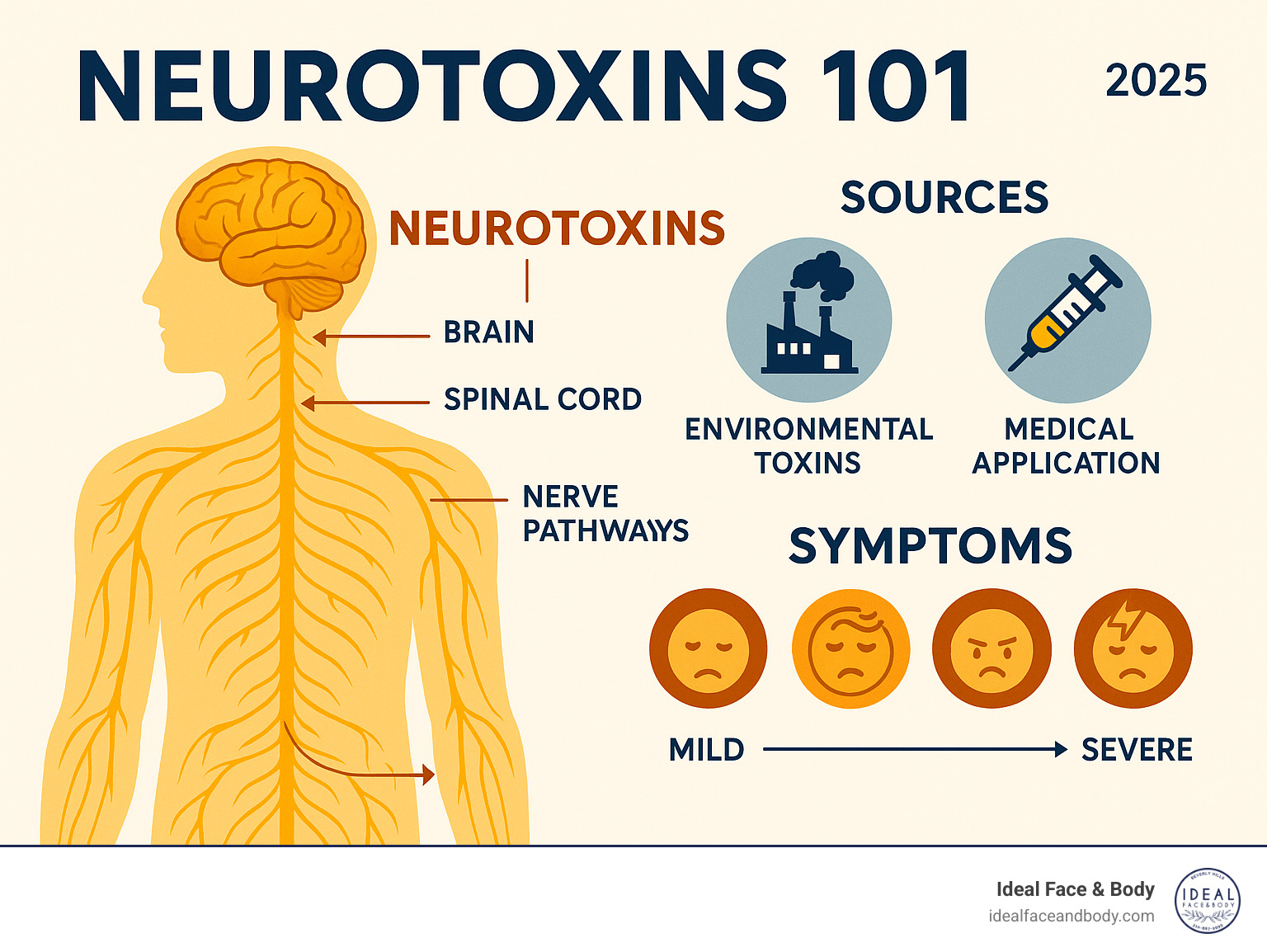What Are Neurotoxins and Why Should You Care?
Neurotoxins are substances that alter the structure or function of the nervous system. While this might sound alarming, the reality is more nuanced than you might expect.
Quick Facts About Neurotoxins:
- Definition: Chemicals that damage, change, or kill nerve cells
- Sources: Both natural (snake venom, botulinum toxin) and human-made (pesticides, solvents)
- Effects: Range from mild symptoms to severe neurological damage
- Exposure Routes: Breathing, consuming, or skin contact
- Notable Stat: More than 1,000 chemicals are known to have neurotoxic effects in animals
- Surprising Twist: Some neurotoxins have beneficial medical and cosmetic uses when properly administered
The term “neurotoxin” often triggers fear, but understanding these substances is crucial for making informed decisions. Not all neurotoxins are created equal; while some cause serious harm, others have been safely transformed into powerful therapeutic tools.
The nervous system controls everything from your heartbeat to your facial expressions. When neurotoxins interact with this complex network, they can disrupt communication between nerve cells, leading to effects ranging from temporary muscle relaxation to severe neurological symptoms.
What makes this topic relevant today is that purified neurotoxins, specifically botulinum toxin, have revolutionized medical and cosmetic treatments. These substances, dangerous in their raw form, become precise tools when administered by trained professionals like Dr. Sarah Yovino, a specialist in non-surgical medical aesthetics with deep insight into their science and application.
Basic Neurotoxins terms:
How Neurotoxins Impact the Nervous System
Think of your nervous system as your body’s electrical grid. When neurotoxins enter this system, they can disrupt the communication lines, sometimes temporarily and sometimes permanently.
How Neurotoxins Enter Your Body
Neurotoxins can enter our systems through inhalation of contaminated air, ingestion of contaminated food or water, or skin contact with certain chemicals. Once in the bloodstream, they travel throughout the body, impacting both the Central Nervous System (your brain and spinal cord) and your Peripheral Nervous System (all the nerves branching out to the rest of your body).
The Two Ways Neurotoxins Cause Damage
Neurotoxins are remarkably precise, working through two main mechanisms: disrupting communication between neurons or directly damaging and killing nerve cells (a process called neuronopathy). The communication disruption happens at synapses—the tiny gaps where nerve cells pass messages. The cells are still alive but can’t talk to each other effectively.
A Closer Look at Clostridial Neurotoxins
Some of the most fascinating examples come from clostridial neurotoxins, including botulinum and tetanus toxins. These substances are incredibly potent and work by blocking neurotransmission. Botulinum neurotoxins target your peripheral nervous system where nerves meet muscles. They act like molecular scissors, cutting proteins essential for releasing acetylcholine—the chemical messenger that tells your muscles to contract. When this is blocked, muscles relax. In contrast, tetanus toxin travels to your central nervous system, causing continuous muscle contractions. The scientific research on bacterial neurotoxins reveals just how sophisticated these mechanisms are.
Temporary Relief vs. Permanent Damage
Not all neurotoxin exposure leads to lasting problems. The effects can be temporary or irreversible, depending on the toxin, dose, and duration of exposure. Temporary effects are the principle behind cosmetic neurotoxin treatments, where controlled amounts create desired effects that naturally wear off. Irreversible damage occurs with more potent toxins or chronic exposure, which can permanently destroy neurons, leading to lasting neurological problems.
Understanding these mechanisms helps explain why neurotoxins can be both dangerous hazards and valuable medical tools—it’s all about precision, dosage, and expert application.
Common Types and Sources of Neurotoxins
Neurotoxins are surprisingly common, and understanding their sources helps us make better choices about daily exposure and appreciate how dangerous compounds can be transformed into beneficial treatments.
-
Natural Sources: Nature produces neurotoxins as defense mechanisms, such as snake venom and the tetrodotoxin in puffer fish. Bacteria give us some of the most potent examples, like botulinum toxin and tetanus toxin. While a tiny amount of botulinum toxin can be lethal, its purified form has revolutionized medicine and cosmetics.
-
Environmental Sources: Heavy metals like lead and mercury have contaminated many areas through industrial activity. Lead was once common in paint and plumbing, while mercury can be found in contaminated fish. Pesticides and herbicides, designed to disrupt insect nervous systems, can also affect humans. These environmental chemicals require careful handling.
-
Man-Made and Recreational Sources: Industrial solvents in paints and cleaners can be harmful with repeated exposure. More concerning are chemical weapons like Sarin gas. Even recreational substances can be neurotoxic; ethyl alcohol in excess can cause serious brain damage, and illicit drugs like cocaine and heroin directly damage nerve cells.
Context and dosage completely change a substance’s impact. The same botulinum toxin that causes deadly food poisoning becomes a precise medical tool when purified and administered by professionals. Understanding these diverse sources helps us steer our world more safely.
Recognizing the Symptoms of Exposure
When neurotoxins affect your body, the symptoms can be as varied as the substances themselves, appearing quickly or developing slowly over time. Understanding these warning signs is crucial.
Acute symptoms often appear quickly after exposure and can include a persistent headache, dizziness, or poor coordination. The severity often depends on the amount of neurotoxin you were exposed to.
Chronic symptoms develop from repeated exposure or when the initial damage takes a while to show up. This is where things can get more concerning:
- Memory loss might start subtly but can progress to more serious cognitive decline.
- Mood changes are another red flag, such as unusual irritability, anxiety, or increased aggression.
- Executive dysfunction can make simple decisions and planning feel overwhelming.
- Fatigue from neurotoxin exposure is a profound exhaustion that doesn’t improve with rest.
- Physical symptoms can include muscle weakness, tremors, vision problems, and numbness or tingling in your hands and feet.
The potency of some neurotoxins is staggering. Sarin gas can be lethal within 10 minutes, while botulinum toxin is so powerful that less than one microgram can be deadly if inhaled. These statistics underscore why recognizing symptoms early is so important.
Neurotoxin symptoms can mimic other conditions, but when multiple symptoms appear together after potential exposure to toxic substances, it’s worth taking them seriously. Pay attention to changes in how you feel and function.
Emergency Signs of Neurotoxicity
While some neurotoxin symptoms develop slowly, others are emergencies that demand immediate action. Think of these signs as your body’s fire alarm.
-
Breathing and swallowing difficulties are among the most serious red flags. When neurotoxins affect the muscles controlling these vital functions, every second counts.
-
Sudden paralysis is another unmistakable emergency sign—the sudden inability to move arms, legs, or facial muscles.
-
Seizures or convulsions represent the nervous system in chaos and require immediate medical intervention.
-
Loss of consciousness, whether fainting or unresponsiveness, signals that neurotoxins have reached critical levels.
Other emergency signs include sudden vision loss, extreme confusion, and dramatic changes in heart rate. If you witness any of these symptoms, call emergency services immediately. Neurotoxin emergencies are a race against time; the faster someone receives treatment, the better their chances of recovery and minimizing long-term damage.
Vulnerable Populations and Long-Term Complications
While neurotoxins can affect anyone, some populations are more susceptible to their harmful effects. The developing brain, the aging brain, and individuals with compromised health are particularly at risk.
Why Children and the Elderly Are More Vulnerable
-
Children and Infants: Their developing nervous systems are exquisitely sensitive to neurotoxins. Exposure during this critical period can disrupt brain development, leading to permanent damage. Children also have higher exposure rates relative to their body weight and less mature detoxification systems. Exposure to neurotoxicants in early childhood has been associated with conditions like autism and ADHD.
-
The Elderly: As we age, our bodies become less efficient at clearing toxins. The blood-brain barrier may weaken, and liver and kidney function can decline, leading to longer retention of neurotoxins. Lifetime cumulative exposure can also contribute to age-related neurological decline. You can find more general information on More on vulnerable populations.
The Impact of Neurotoxins on Fetal Development
The impact of neurotoxicity during pregnancy is a major concern, as many toxins can cross the placenta from mother to fetus.
- Fetal Alcohol Syndrome (FAS) is a classic example, where alcohol damages the developing fetal brain, causing lifelong cognitive and physical problems.
- Other Exposures: Exposure to other neurotoxins like lead or mercury during fetal development can contribute to developmental delays, lower IQ, and behavioral issues.
- Medication Safety: This is why providers are so cautious about medications during pregnancy. Understanding Why some medications are unsafe in pregnancy is vital for expectant mothers.
Combined Effects of Multiple Neurotoxin Exposures
We are rarely exposed to just one neurotoxin at a time. There is growing concern about the combined effects of multiple exposures, even at low levels. This concept, known as synergistic toxicity, suggests the combined effect might be greater than the sum of individual effects, highlighting the importance of minimizing overall exposure.
The Surprising Therapeutic Uses of Neurotoxins
It might seem counterintuitive, but some of the most potent neurotoxins have been transformed into powerful therapeutic and cosmetic treatments. This illustrates a key principle in medicine: the dose makes the poison. What is deadly in large amounts becomes beneficial in tiny, controlled doses.
Botulinum Toxin: From Toxin to Treatment
The most remarkable example is purified botulinum toxin type A. Derived from the bacteria that causes botulism, scientists have learned to purify and dilute this life-threatening toxin into a safe, effective treatment that has revolutionized both medicine and cosmetic care.
Medical Applications: Beyond Beauty
Purified botulinum toxin is a game-changer for many medical conditions by precisely targeting specific muscles or glands.
- Muscle Spasms and Dystonia: It offers relief for conditions like cervical dystonia (neck spasms) and blepharospasm (eyelid twitching) by blocking nerve signals that cause excessive muscle contraction.
- Chronic Migraine: For those with frequent headaches, strategically placed injections can reduce the frequency and intensity of migraines.
- Hyperhidrosis (Excessive Sweating): This neurotoxin can block nerve signals to sweat glands, providing months of relief.
Cosmetic Applications: Sculpting and Smoothing
In aesthetic medicine, purified botulinum toxin is the gold standard for non-surgical facial rejuvenation by temporarily relaxing the muscles that create dynamic wrinkles.
- Reducing Fine Lines and Wrinkles: It significantly softens frown lines, crow’s feet, and forehead lines for a refreshed, natural look.
- Facial Contouring: Skilled practitioners use it for subtle shaping, like slimming a prominent jawline or creating a “lip flip.”
The beauty of this treatment is its temporary and targeted muscle relaxation. The effects are reversible, and precision allows for natural-looking results. The duration varies, which is why certain formulations are preferred for different applications.
Expertise is crucial for both medical and cosmetic uses. At Ideal Face & Body, Dr. Sarah Yovino and Dr. Justin Yovino use their extensive knowledge of facial anatomy and neurotoxin behavior to ensure optimal, safe, and natural-looking results.
Frequently Asked Questions about Neurotoxins
The topic of neurotoxins can feel overwhelming, as they can be both poisons and treatments. Let’s tackle the most common concerns.
Can the effects of neurotoxin exposure be reversed?
It depends on the type of neurotoxin, the dose, and how quickly treatment begins.
- Temporary Damage: The body can often heal from temporary damage. For example, the effects of purified botulinum toxin used in cosmetic treatments wear off over several months as nerve endings sprout new connections.
- Permanent Damage: If neurotoxins kill nerve cells, the damage is often irreversible. This is why conditions like Fetal Alcohol Syndrome cause lifelong challenges.
- Early Intervention: The sooner a person gets medical help after toxic exposure, the better the chances of minimizing long-term effects. Time is critical.
How can I reduce my exposure to common neurotoxins?
There are practical steps you can take to protect yourself and your family.
- Be Aware of Your Environment: Use good ventilation when using household cleaners or pesticides and follow all safety instructions.
- Watch Your Diet: Eat antioxidant-rich foods to support your body’s detox systems. Be smart about fish choices to avoid high-mercury options. A good water filter can also help.
- Practice Safe Habits: Choose organic produce when possible, practice proper food handling, and avoid excessive alcohol and illicit drugs, which are potent neurotoxins.
Are all neurotoxins lethal?
Absolutely not. The world of neurotoxins is diverse, ranging from mildly irritating to extremely dangerous.
- Potency Varies: Some neurotoxins like botulinum toxin are incredibly potent, but when purified and used in tiny, controlled doses, they are safe and effective.
- The Dose Makes the Poison: This principle explains how we can safely use substances that would be dangerous in larger amounts.
- Exposure Matters: The route (inhalation vs. skin contact) and duration of exposure are key factors. Individual factors like age and health also influence how someone responds.
While some neurotoxins are lethal, many others cause a range of effects. Understanding the substance, dose, and exposure helps us make informed decisions.
Conclusion: A Balanced Perspective
Our exploration of neurotoxins reveals a remarkable story: substances that are harmful in their natural state become powerful allies when harnessed by science and medicine. Understanding and expertise can turn potential danger into therapeutic benefit.
We’ve seen how neurotoxins can disrupt the nervous system and that uncontrolled exposure can lead to lasting complications, especially for vulnerable populations. Yet, we’ve also finded that when purified and administered by professionals, certain neurotoxins like botulinum toxin become precise tools for healing and cosmetic improvement.
The difference lies entirely in expertise and control. The same substance that is dangerous in its raw form becomes a tool for subtle rejuvenation when processed and injected with precision. It’s science applied with skill and a deep understanding of facial anatomy.
For those in Beverly Hills, CA, considering cosmetic treatments with purified neurotoxins, the provider makes all the difference. At Ideal Face & Body, Dr. Sarah Yovino and Dr. Justin Yovino bring specialized training in both the science and artistry required for natural-looking results.
The key takeaway: Respect the power of neurotoxins while appreciating their benefits. Avoid uncontrolled exposure, but don’t let fear prevent you from exploring their therapeutic uses when administered by qualified professionals.
Ready to learn how these precisely applied treatments can help you achieve your aesthetic goals safely and effectively?










